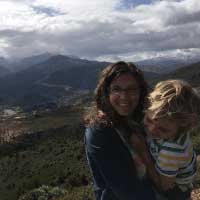Hygge, Ikigai & Fredagskos: How to Stay Happy in the Winter Months
Counseling Schools Search
When you click on a sponsoring school or program advertised on our site, or fill out a form to request information from a sponsoring school, we may earn a commission. View our advertising disclosure for more details.
“People are put in a very positive but relaxed mood through these different conditions. That’s what many of us are really looking for in our homes: a refuge or retreat, a place where you restock your energy to go back out into the world again.”
Dr. Sally Augustine, Principal Designer at Design with Science
Winter months can be challenging for a lot of people. Many of the states in the northern part of the contiguous United States can have as few as eight or nine hours of daylight, as the sun sets before 5 pm. While the dark presents its own challenges, the cold and ease of isolation can compound feelings of sadness and loneliness.
The estimated number of Americans experiencing seasonal affective disorder (SAD) is approximately 10 million, although some experts estimate it could be as high as 20 percent of the population. SAD is characterized by depression, disinterest in everyday activities, excessive sleepiness, anxiety, and social isolation. In addition to SAD, which is a serious medical condition, many more people have the winter blues, making performing everyday activities more difficult.
Other countries that also experience long and dark winters have developed traditions and rituals to help deal with the loneliness and sadness that can creep in this time of year.
One such tradition is called hygge and originates from Denmark. Hygge, the practice of coziness, really came onto the scene in the US in the late 2010s with numerous books, articles, and guides published to help Americans learn about this custom.
Since the introduction of hygge to the US, many other cultural practices that can help with winter blues have emerged, including ones from Norway, Japan, and even Germany. Integrating some of these practices into daily life can help improve relaxation, happiness, and general wellbeing over the winter months.
Continue reading to learn about these practices and how to implement them from Dr. Augustine, an environmental and design psychologist expert.
Meet the Expert: Sally Augustin PhD

Dr. Sally Augustin is the principal designer at Design with Science, a neuroscience consultation firm that makes recommendations on how to design spaces to improve mental health. She is an environmental and design psychologist and earned her PhD from Claremont Graduate University. Her primary area of expertise is in using science-based insights to make recommendations for spaces that support cognitive, emotional, and physical well-being.
Dr. Augustin is also a Fellow of the American Psychological Association and holds leadership positions in the American Psychological Association and the Environmental Design Research Association. She is an author with several published books, including Designology, Place Advantage: Applied Psychology for Interior Architecture and The Designer’s Guide to Doing Research: Applying Knowledge to Inform Design. In addition, she is the editor for Research Design Connections, where she frequently publishes articles about science-based design.
What Are Hygge, Ikigai & Fredagskos?
Countries that have a strong sense of culture have their own words to describe ways of moving through the world. In particular, many countries that have long, cold winter months have words that convey methods of dealing with the dark and isolation.
Other countries, particularly Scandanavian and Asian ones, can have words that describe a generally positive attitude that can help with the winter months. Here are the definitions, as best they can be described in English:
- Hygge: A Danish and Norwegian word for a mood of comfortable and coziness that can come from contentment and wellness. More specifically, creating a warm and comfortable atmosphere and enjoying the good things in life.
- Ikigai: A Japanese word that encompasses a motivating force of the reason for doing something. The literal translation is the reason you wake up in the morning.
- Fredagskos: A Norwegian word that literally means Friday coziness. It is characterized as a Friday evening spent at home warm with family and friends. Often, this practice also includes indulgences such as yummy foods or treats.
“They’re all in some ways the same. In my experience, they all involve things such as warm and low light, soft and comforting textures, relaxing scents. Things like that to make a nest a loveliness,” says Dr. Augustin.
These practices can all help people stay happy during the winter months. “People are put in a very positive but relaxed mood through these different conditions. That’s what many of us are really looking for in our homes: a refuge or retreat, a place where you restock your energy to go back out into the world again. If you know about the principles involved, you can actualize the important elements in ways that can encourage that kind of positive, relaxed experience,” encourages Dr. Augustin.
How to Put Well-Being Concepts Into Practice
While hygge, ikigai, and fredagskos each have individual elements, as Dr. Augustin already noted, there are many similarities. Dr. Augustin offers the following tools, rooted in these cultural words and practices, that she has found through her research and experience that can help people stay happy in the winter months.
Fire
“Hygge often involves some sort of fire. You know the stereotype of this experience is in front of a fireplace and a fire creates a very warm light that’s not very bright,” says Dr. Augustin.
But a fire inside a house isn’t accessible to everyone. “You can change some of the bulbs in the fixtures in your home, so they’re warm, and only turn on maybe one of those fixtures in order to create the same sort of warm, dim light that you would get from a fire,” she offers.
She continues, “The warmth and the intensity, the degrees Kelvin of the light, is really what’s relaxing.” The intensity of light is measured in Kelvin degrees, with higher numbers being brighter and lower numbers being warmer and dimmer. So, ideally, for a warm hygge feeling, bulbs would emit light that is 2700k or lower.
Lighting a candle can also be a way to recreate fire without a fireplace. In fact, up to 27 percent of Danes light a candle in their home every day to bring a sense of hygge into their home.
Find Things That Are Effortlessly Fascinating
“Fire in and of itself is relaxing to look at because of the movement of the flames as stuff burns,” shares Dr. Augustin. “It is what’s known as effortlessly fascinating when you find yourself drawn in, and you become focused on the movement of the flames. You give your mind the opportunity to refresh after it’s been depleted doing the sort of focused and concentrated work that most of us do in the course of our work lives. It can help restock your mental energy.”
While fire may not be a viable option for many, Dr. Augustine has many alternatives. “There are other things that are effortlessly fascinating for us to look at. One of them is like nature through a window, or nature that you might project onto the walls of your home through photography or a video. You can pull up nature videos on your laptop that include scenes with a lovely meadow on a spring day with sunlight and gently moving grasses, or leaves gently undulating in the breeze,” she offers.
“Watching fish swim in a regular home aquarium is also effortlessly fascinating,” she says. “You can introduce an aquarium to an apartment which is a lot more doable than being able to add a natural fireplace apartment. There are a lot of ways to create basically the same experience from a psychological perspective.”
Smells
“Another component of hygge is scent,” says Dr. Augustine. “These can be warm, relaxing smells, from food or from a fire, or you can also add the smell of lavender to your home.
In fact, using lavender is backed by science. “Aromatherapists have always been talking about lavender as a smell that’s relaxing. Well, it turns out when you take lavender into the lab, science does confirm that it’s relaxing,” she says. Studies have found that lavender can ease patient anxiety before surgery, reduce pain during labor, and help with insomnia in the elderly.
Dr. Augustine even suggests adding the aromatic component to an effortless fascinating experience.
Foods
One of the central components of hygge and fredagskos is food. Dr. Augstine shares, “There’s a really important element of comfort foods that you have associated memories to that are more relaxing and comforting. For example, sugar cookies and hot cocoa. We are talking about the kinds of foods with really positive and relaxing associations. Often these foods are cultural, like for Scandinavians, they have smoked fish.”
However, smoked fish isn’t for everyone. “That probably would not have the same effect for me,” says Dr. Augustine. “You may have personal associations with things like what your grandma used to make Christmas Eve. The smells of those things and tastes will stay with you in a positive way throughout your life.”
Textures and Fabric
Lastly, texture and fabric also can play a crucial role in helping to keep spirits high in the winter months. According to Dr. Augustine, “They tend to be of natural fibers or biophilic (lifelike) design. Soft textures such as flannel terms or things that feel soft on our skin are ones that have really positive associations.”
Many of the guides and tutorials on hygge talk about creating a little nest using soft blankets and pillows. Preferably by fire for the warm lighting, smell, and effortless fascination. Warm and cozy socks are also something that is frequently used to experience the cozy nest sensation while at work or on the go.
A Note About Mental Health
While hygge, ikigai, and fredagskos can help with the winter blues, Dr. Augustine emphasizes that this is not a cure or treatment for serious mental health disorders. “When I’m talking about these things, I’m not talking about them as a clinical psychologist. I’m talking about them as an applied environmental psychologist. Seasonal affective disorder can be a really very serious psychological condition that requires treatment by clinician,” she says.
Here are some resources for those experiencing seasonal sadness and need a little extra support:
- Substance Abuse and Mental Health Services Administration National Helpline
- National Institute of Mental Health sheet on how to talk to your healthcare provider
- Mayo Clinic’s guide on light therapy for seasonal affective disorder

